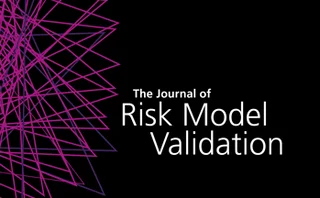Stress scenarios
International Financial Reporting Standard 9 expected credit loss estimation: advanced models for estimating portfolio loss and weighting scenario losses
In this paper, the authors propose a model to estimate the expected portfolio losses brought about by recession risk and a quantitative approach to determine the scenario weights. The model and approach are validated by an empirical example, where they…
CECL muddies stress tests for US banks
Accounting forecasts differ from Fed’s CCAR scenarios; banks seek middle way to avoid upfront capital hit
Funds try to predict behaviour of mystery investors
New EU rules on liquidity stress-testing force fund managers to hunt out clues on investors
Quantifying systemic risk using Bayesian networks
Creditworthiness of individual entities may offer an insight into systemic risk of financial markets
US banks anticipate fresh guidance on resolution liquidity
Consultation in first half of 2020 expected to clarify intra-group and forecasting requirements
CCAR more severe than EU stress tests
Real GDP decline greater for US banks under Fed tests than for EU firms grilled by the EBA
EU’s 2020 stress tests are toughest to date
Real GDP projected to contract –4.3% over three-year scenario horizon
CECL drains $2.9bn from Capital One’s CET1
Core capital ratio to fall 16 basis points following switch to new accounting standard
As business mix shifts, Eurex bulks up its default fund
Clearing house will raise charge to 9% from 7% as stress tests signal need for a fatter fund
Four UK banks improve resilience to stress tests compared with 2018
Aggregate CET1 capital ratio headroom over hurdle rate improves by 50 basis points
UK banks pass BoE stress tests
Dividend and AT1 bond coupon cuts needed to clear minimum requirements
Banks step up stress-testing of Hong Kong dollar peg risk
Flurry of forex options trades makes banks re-evaluate exposures
The Fundamentals of market risk rules
With the 2022 Fundamental Review of the Trading Book (FRTB) deadline looming, banks are fast coming to grips with the amount of work still to be done to achieve a successful implementation
Competitive differentiation – Reaping the benefits of XVA centralisation
A forum of industry leaders discusses the latest developments in XVA and the strategic, operational and technological challenges of derivatives valuation in today’s environment, including the key considerations for banks looking to move to a standardised…
Mid-cycle stress tests tougher on banks than DFAST
Median CET1 ratio drops 200bp more under mid-cycle than Fed-run tests
Quants bring ‘triptych’ of variables to risk measurement
Risk and portfolio managers at La Francaise and LFIS are squeezing more information out of stress tests
BNY, Goldman, HSBC lag in mid-cycle stress tests
Periodic health checks show banks would hurdle regulatory minimums under severe market crisis
French banks, jump-to-default and STS for synthetics
The week on Risk.net, October 26–November 1, 2019
Better risk reporting doesn’t need an IT upgrade
By revisiting certain calculations, new insights into risk and profit drivers can be gained, says data scientist
French banks cry foul over EBA’s 2020 stress-test plan
Assumptions about the cost of household sight deposits are “not plausible”, critics say
Stress-testing to improve strategic decision‑making
Banking regulators remain focused on expanding and developing the range of stress-testing regimes across the globe to maintain stability, monitor emerging risks and avoid another financial crisis. Here, a forum of industry leaders discusses the evolution…
A triptych approach for reverse stress testing of complex portfolios
Pascal Traccucci et al present an extended reverse stress test triptych approach with three variables
Keeping watch: EBA stress-testing head plans overhaul
Top-down approach, dynamic balance sheet and multiple shock scenarios all possible for 2022
Fund fears linger over guidelines set to avert fire sales
Final Esma framework allays some European asset managers’ concerns


















